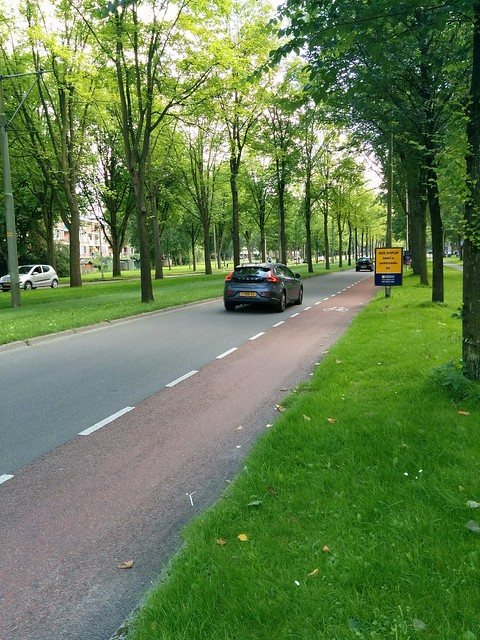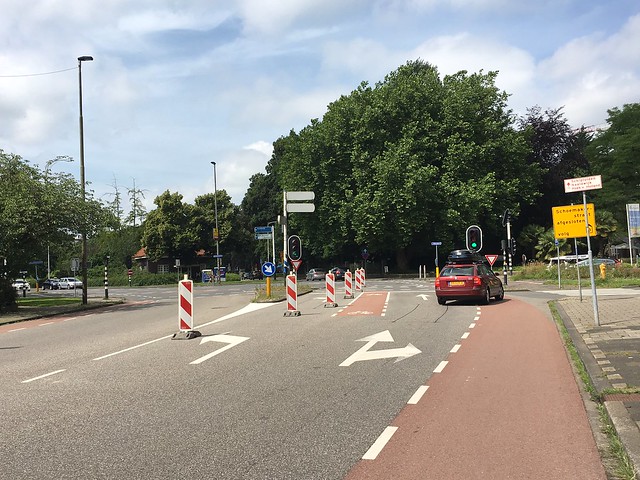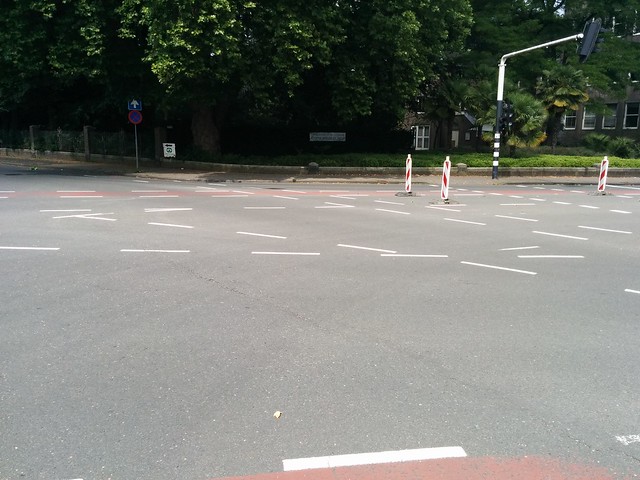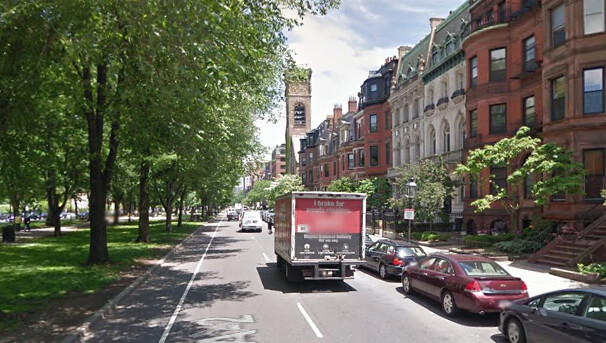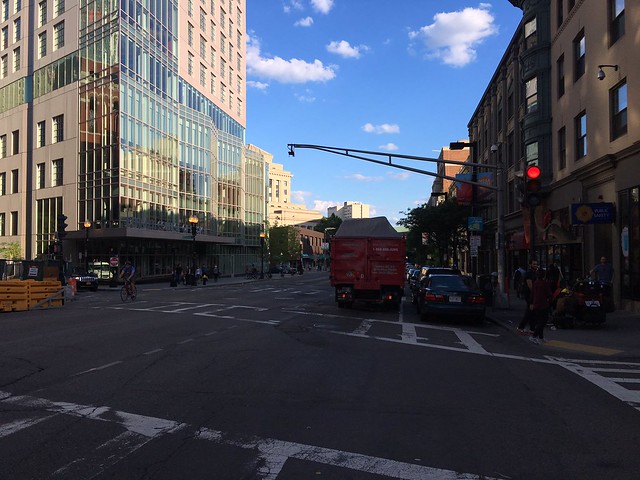What makes for a good bike lane?
Unlike cycle tracks that provide vertical and or horizontal separation from other users, bike lanes provide cyclists their own lane and discourage drivers from intruding into their space, using dashed lines and red paint. Riding on a bike lane can be stressful at times, especially if there’s parking on your right and fast driving vehicles on your left. Bike lanes must cater for a cyclist’s space needs and when alongside parking, the door reach of the parked car to avoid “dooring”. They aren’t expensive to build and are a good option if there’s no (high turnover) parking and only one travel lane parallel.
The dutch bicycle design manual (CROW) specifies two street types where bike lanes are preferred, on a local road where the maximum speed is 30 km/h (20 mph) and there are more than 2000 cyclists per day or on an access road where the maximum speed is 50 km/h (30 mph) if there’s only one lane per direction. Also, bike lane widths must be a minimum of 1.5 meters and if alongside parking, a critical reaction strip (minimum of 0.5 meters) is recommended. It’s also recommended that designers check to see if they can build a cycle track alongside parking, given the extra width requirements needed for a lane.
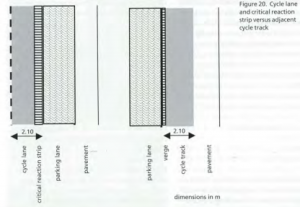
Diagram from the CROW manual, showing the desired widths of a bike lane alongside a parking lane. It’s compared to a cycle track along a parking lane to encourage designers to think of that as an option too.
When bike lanes run alongside bus routes, the CROW manual recommends that they’re transformed into cycle tracks, bypassing the whole bus stop area and so minimizing any conflict with the buses. If no space was available, a bus stop bay is required that’s wide enough to ensure the bus does not encroach onto the bike lane when it’s parked. This treatment was seen on all of the bike lane ridden.
Riding along a typical bike lane in the Netherlands, there is a feeling of comfort and safety. Lanes are usually located on the right side of road, along the curb. They are a distinguishable red, usually a red asphalt treatment. Lane spacing typically allows for rider comfort and safety, with many lanes wide than the minimum of five feet. For example along Buitenhofdreef, two cyclists could ride abreast in the one-way bike lane. I felt confident, safe, and comfortable that I did not have to fight with motor vehicles over lane space, but still felt that I had to be aware of motor vehicles at all times since I was sharing the roadway.
Photo Above: Typical bike lane in the Netherlands. Along Buitenhofdreef.
How do left-turning cyclists interact with traffic at signalized intersections?
The CROW manual discusses this issue and describes cyclists turning left as the ones who often draw the short straw in a traffic control situation, mainly due to the high delay, but it does outline treatment options to reduce these delays.
Cyclists on bike lanes have three possible treatment options at signalized intersections, if they’re turning left.
1. Do nothing
The simplest and cheapest option is to end the bike lane and let bicycles find their way across an intersection. The most unsafe option, as it forces bicycles to merge with traffic. If it is so unsafe, a cyclist may choose to become a pedestrian and walk their bike across at the pedestrian crossings. This treatment, although very common in the United States, was not seen in the Netherlands. Bike lanes can also continue straight through an intersection, maintaining the through cyclist’s space but not the cyclists wanting to turn left/right. Most left turning cyclists will choose to merge with traffic to make their turn as it’s safer and more convenient.
2. Left-turn bike lanes
Pavement markings for left-turns have two possible treatments. Either a pocket left turn bike lane, or a two-stage left turn with a queue box.
Pocket Left Turn Lane
A pocket left turn lane is placed on the right of a vehicle left-turn lane. This allows the cyclist to have a clear delineated space while queueing and traveling across the intersection, but causes problems in the intersection approach. To reach a pocket left turn lane a cyclist must weave across traffic from any cycling infrastructure on the right side of the road. The more lanes, the more dangerous and difficult it is. The CROW manual does limit this treatment to streets with a maximum speed of 50 km/h and one lane of traffic to cross.
Julianalaan at Nassaulaan:
An intersection with non aligned or perpendicular approaches, Julianalaan approaches have three vehicle lanes and two bicycle lanes while Nassaulaan has two vehicle lanes with two bicycle lanes. Schoemakerstraat also intersects, with three lanes and one bicycle. Pocket left turn bicycle lanes on Julianalaan and Nassaulaan are approximately 65’ long. Though the left turn bicycle lanes only cross one lane of oncoming traffic, they must pass through a wide swath of pavement. On the approach to the intersection, the weaving to the left turn pocket bike lane felt stressful. As I arrived during a green light, I felt vulnerable and had to be aware exactly what a vehicle in the through lane was doing to be able to safely reach the pocket lane for a left turn. Even in a through movement, cyclists on Nassaulaan had to worry about right turn vehicles weaving through their lane.
Photo Above: Nassaulaan approach to intersection with Juilanalaan. Left turn lane closed due to construction along Schoemakerstraat.
While riding through this intersection, attempting to make a left turn from Julianalaan southbound to Nassaulaan eastbound, the amount of pavement markings felt confusing to understand for a first time user. I was unsure what path I should be following to complete my movement.
Photo Above: Confusing Pavement Markings in intersection for first time users. Taken from median at Nassaulaan approach facing the intersection.
Two Stage Left Turn with a Queue Box
A two-stage left turn with a queue box is the more safe of the two left-turn bike lane treatments. This requires cyclists to cross through the intersection. They then enter a queue box in front of the through movement of the perpendicular street. The movement is completed in two stages so it will cause more delay, but will require less conflicts with vehicle movements.
Buitenhofdreef at Van der Slootsingel:
Two-stage left turns exist for cyclists for Buitenhofdreef in either direction. Cyclists move with the through movement, but then enter and stop at a queue box to the right of the bike lane. The box is in front of the through movement for Van der Slootsingel and not interfering with other vehicular movements. There is a bike signal for the second stage of the movement. While riding, the facility felt relatively stress free. I was not in the way of any traffic, there was a visible signal, and I could easily figure out what to do as a first time user.
Photo Above: Queue box for two-stage left turn with bicycle signal. Buitenhofdreef at Van der Slootsingel.
3. Refuge cycle tracks:
Another treatment for left turning cyclists on bike lanes is for the lanes to transform into cycle tracks upon reaching the signalized intersection. This is a safe way for cyclists to turn left, but will require, similar to the queue box treatment above, two stages and thus will cause delays for the cyclists.
Buitenhofdreef at Martinus Nijhofflaan:
The southbound bicycle lane along Buitenhofdreef merges onto an offset protected track to allow continuous movement through the T intersection. Small breaks in the median allow bicycles to enter the southbound bicycle lane, but still provide separation from vehicles. Riding through this intersection felt safe and easy. Completing a through movement was stress free as I didn’t have to pay much attention to the intersection.
Photo Above: Buitenhofdreef at Martinus Nijhofflaan (from Buitenhofdreef southbound) allowing for protected bicycle through movements and left turns from/onto Martinus.
Completing a left turn from Martinus Nijhofflaan (not pictured), from a bicycle lane, it was clear where I was supposed to head to enter in the refuge area.
Bike Lanes in the United States
The bike lane on Commonwealth Avenue can be considered as a “good bike lane”. It’s on a 2-lane one-way street and runs on the left side of the street along a curb and away from parked cars. The lane width is 5 ft, a cyclist needs 4 ft of travel space and a 1 ft buffer from same-direction traffic, making the lane width sufficient.
Photo Above: Commonwealth Avenue typical bike lane.
Because most of the side streets running through the Avenue are one-way, there’s no general left or right-turn movement treatment that can be implemented at all the intersections. Where a left turn is allowed, cyclists on the bike lane (located on the left side of the street) can easily connect to a bike lane on the side street, avoiding conflict with turning vehicles. Where a right turn is allowed, bike boxes should be put ahead of car stop lines so cyclists can move from the left to the right of the street and make their turn first. Two-stage right-turns can be made too, using queue boxes ahead of the bike lane on the perpendicular street.
Photo Above: Typical left turn treatment along Commonwealth Avenue to be improved with pavement markings guiding cyclists to lane on the side street.
The bike lane on Massachusetts Avenue, heading into Boston from the Harvard Bridge, can be considered as a “bad” bike lane where a cycle track is the best option. It runs alongside commercial (high turnover) parking and is often blocked by double-parked vehicles and loading trucks. Cycling alongside 2+2 travel lanes can be stressful at times, too. Also, no bus stop bypass treatments are implemented on the street, creating added stress to cyclists having to maneuver around the stopped buses.
Photo Above: Typical blockage of bike lanes along Massachusetts Avenue. Photo courtesy of Jonathan Fertig.
When cyclists approach signalized intersections, no known treatment is applied for cyclists, they’re mostly expected to merge with traffic if they want to turn left. The possibility of getting right-hooked is high too, because right-turning cars weave into the bike lane to turn.
Photo Above: Typical encroachment of bike lanes along Massachusetts Avenue.

